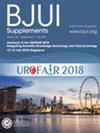术中锥形束计算机断层扫描对经皮肾镜取石术的长期影响:18个月回顾性随机对照试验分析。
IF 4.4
2区 医学
Q1 UROLOGY & NEPHROLOGY
引用次数: 0
摘要
目的评估术中锥形束计算机断层扫描(CBCT)对经皮肾镜取石术(PCNL)后结石相关发病率的长期影响,因为术中CBCT允许在同一过程中检测和去除残留碎片,改善结石清除,从而潜在地减少结石相关发病率。患者和方法本研究是对先前在三级复杂泌尿系统中心进行的单中心随机对照试验的回顾性分析,在该试验中,患者被随机分为术中PCNL合并术中CBCT或常规PCNL。我们分析了18个月的随访数据,以评估结石相关事件(SREs)的差异,包括再次干预、急诊就诊和住院。通过随访CT扫描确定的结石清除率和结石复发时间也进行了评估。结果CBCT组(n = 80)在18个月的随访中有29例(36%)病例,而常规PCNL组(n = 80)有40例(50%)病例,CBCT组(n = 80)的新碎片或残留碎片检出率明显低于常规PCNL组(n = 80)(风险比[HR] 0.61, 95%可信区间[CI] 0.38-0.97)。CBCT组碎片检测的限制平均(标准差[SD])时间为420(44)天,而传统PCNL组为318(53)天。在CBCT组中,15例(19%)患者经历了26例SREs,而在常规PCNL组中,23例(29%)患者经历了39例SREs。CBCT病例到SRE的限制平均(SD)时间为499(26)天,而传统PCNL病例为447(39)天。与常规PCNL相比,CBCT-PCNL的SREs发生率没有显著降低(HR 0.61, 95% CI 0.32-1.17)。结论:本研究发现,与常规PCNL相比,术中CBCT PCNL术后18个月内SREs患者减少10%。这种差异可能是由于单次PCNL合并术中CBCT后无结石率显著增加。本文章由计算机程序翻译,如有差异,请以英文原文为准。
Longer-term effects of intraoperative cone-beam computed tomography in percutaneous nephrolithotomy: 18-month retrospective randomised controlled trial analysis.
OBJECTIVES
To assess the longer-term impact of intraoperative cone-beam computed tomography (CBCT) on stone-related morbidity after percutaneous nephrolithotomy (PCNL), since intraoperative CBCT allows for the detection and removal of residual fragments during the same procedure, improving stone clearance and thereby potentially diminishing stone-related morbidity.
PATIENTS AND METHODS
This study was a retrospective analysis of a previously conducted single-centre randomised controlled trial at a tertiary complex endourology centre, in which patients were randomised intraoperatively to PCNL with intraoperative CBCT or conventional PCNL. We analysed 18-month follow-up data to assess differences in stone-related events (SREs), including re-interventions, emergency department visits, and hospital admissions. Stone-free rates and time to stone recurrence, as determined by follow-up CT scans, were also evaluated.
RESULTS
The CBCT group (n = 80) had a significantly lower detection rate of new or residual fragments >4 mm (hazard ratio [HR] 0.61, 95% confidence interval [CI] 0.38-0.97), with 29 (36%) cases during 18 months of follow-up compared to 40 (50%) cases in the conventional PCNL group (n = 80). The restricted mean (standard deviation [SD]) time to fragment detection was 420 (44) days in the CBCT group vs 318 (53) days in the conventional PCNL group. In the CBCT group, 15 (19%) cases experienced 26 SREs, compared to 23 (29%) cases with 39 SREs in the conventional PCNL group. The restricted mean (SD) time to SRE was 499 (26) days for CBCT cases, compared to 447 (39) days for conventional PCNL cases. The rate of SREs did not decrease significantly when comparing CBCT-PCNL to conventional PCNL (HR 0.61, 95% CI 0.32-1.17).
CONCLUSION
This study found 10% fewer patients with SREs in the 18-month period after PCNL with intraoperative CBCT compared to conventional PCNL. This difference is likely due to the notable increase in stone-free rates following a single PCNL with intraoperative CBCT.
求助全文
通过发布文献求助,成功后即可免费获取论文全文。
去求助
来源期刊

BJU International
医学-泌尿学与肾脏学
CiteScore
9.10
自引率
4.40%
发文量
262
审稿时长
1 months
期刊介绍:
BJUI is one of the most highly respected medical journals in the world, with a truly international range of published papers and appeal. Every issue gives invaluable practical information in the form of original articles, reviews, comments, surgical education articles, and translational science articles in the field of urology. BJUI employs topical sections, and is in full colour, making it easier to browse or search for something specific.
 求助内容:
求助内容: 应助结果提醒方式:
应助结果提醒方式:


